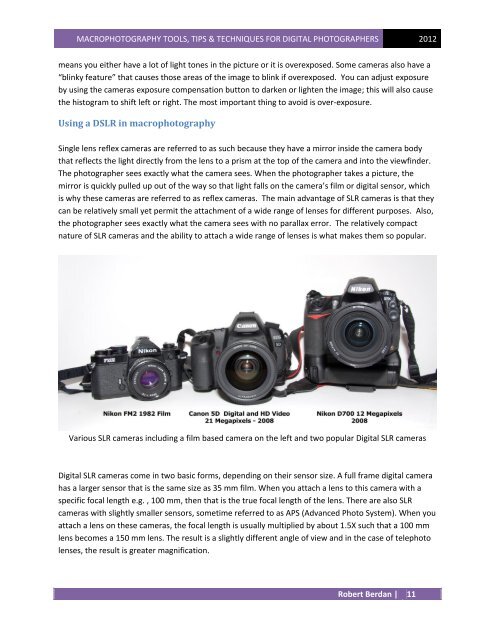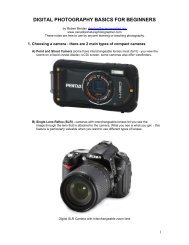Download PDF - The Canadian Nature Photographer
Download PDF - The Canadian Nature Photographer
Download PDF - The Canadian Nature Photographer
You also want an ePaper? Increase the reach of your titles
YUMPU automatically turns print PDFs into web optimized ePapers that Google loves.
MACROPHOTOGRAPHY TOOLS, TIPS & TECHNIQUES FOR DIGITAL PHOTOGRAPHERS 2012<br />
means you either have a lot of light tones in the picture or it is overexposed. Some cameras also have a<br />
“blinky feature” that causes those areas of the image to blink if overexposed. You can adjust exposure<br />
by using the cameras exposure compensation button to darken or lighten the image; this will also cause<br />
the histogram to shift left or right. <strong>The</strong> most important thing to avoid is over-exposure.<br />
Using a DSLR in macrophotography<br />
Single lens reflex cameras are referred to as such because they have a mirror inside the camera body<br />
that reflects the light directly from the lens to a prism at the top of the camera and into the viewfinder.<br />
<strong>The</strong> photographer sees exactly what the camera sees. When the photographer takes a picture, the<br />
mirror is quickly pulled up out of the way so that light falls on the camera’s film or digital sensor, which<br />
is why these cameras are referred to as reflex cameras. <strong>The</strong> main advantage of SLR cameras is that they<br />
can be relatively small yet permit the attachment of a wide range of lenses for different purposes. Also,<br />
the photographer sees exactly what the camera sees with no parallax error. <strong>The</strong> relatively compact<br />
nature of SLR cameras and the ability to attach a wide range of lenses is what makes them so popular.<br />
Various SLR cameras including a film based camera on the left and two popular Digital SLR cameras<br />
Digital SLR cameras come in two basic forms, depending on their sensor size. A full frame digital camera<br />
has a larger sensor that is the same size as 35 mm film. When you attach a lens to this camera with a<br />
specific focal length e.g. , 100 mm, then that is the true focal length of the lens. <strong>The</strong>re are also SLR<br />
cameras with slightly smaller sensors, sometime referred to as APS (Advanced Photo System). When you<br />
attach a lens on these cameras, the focal length is usually multiplied by about 1.5X such that a 100 mm<br />
lens becomes a 150 mm lens. <strong>The</strong> result is a slightly different angle of view and in the case of telephoto<br />
lenses, the result is greater magnification.<br />
Robert Berdan | 11




